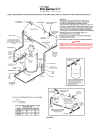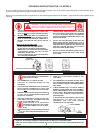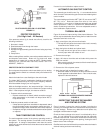
20
SERVICE INFORMATION
The installer may be able to observe and correct certain problems
which may arise when the unit is put into operation. HOWEVER,
it is recommended that only qualified service personnel, using
appropriate test equipment, be allowed to service the heater.
Any safety devices used in conjunction with this appliance should
receive periodic (at least twice a year) inspection to assure proper
operation. All relief valves should be inspected and manually
operated every six months.
PILOT AND MAIN BURNER MAINTENANCE
At least twice a year, check the pilot burner, fig. 15 and the main
burners, fig 13, for proper operation.
The burners should display the following characteristics:
• Provide complete combustion of gas.
• Cause rapid ignition and carryover of flame across entire
burner.
• Give reasonably quiet operation during ignition, burning and
extinction.
• Cause no excessive lifting of flame from burner ports.
If the preceding burner characteristics are not evident, check for
accumulation of lint or other foreign material that restricts or blocks
the air openings to the burners or heater.
Also check for good flow of combustion and ventilating air to the
unit. Maintain a clear area around the heater at all times.
Qualified servicers should follow this procedure when the heater’s
burners need cleaning.
1. Turn off the electrical power and close the main manual gas
shutoff valve.
• Allow heater parts to cool before disassembly.
2. Remove main burner manifold assembly from heater.
• Refer to parts list supplied with this manual for disassembly
aid.
3. Remove any loose foreign material such as dust or lint with a
vacuum. Check all ports, orifices and air openings for blockage.
Dislodge any foreign material causing blockage. Do not use
sharp metal objects to clean blocked orifices as they will
damage the soft brass orifice. Remove any soot or carbon
deposits with a rag making sure to remove any lint left on burner
by vacuuming again.
MAIN BURNER FOR HW HEATERS
FIGURE 13
4. Reinstall the burner manifold assembly on heater.
5. Restore electrical power and gas supply to heater.
• Check for gas leaks and proper heater and vent operation.
I.I.D. PILOT BURNER
Servicing of the pilot burner includes cleaning the burner head
and the orifice of the pilot burner, fig. 15.
The pilot flame should envelop 3/8 to 1/2 in. of the tip of the
insulated rod on the igniter-sensor. If adjustment is required, it is
necessary to establish pilot flame without main burner operation.
For this to happen, perform the following steps.
1. Follow “TO TURN OFF GAS TO APPLIANCE” steps in the
“OPERATING INSTRUCTIONS FOR I.I.D. MODELS”.
2. Carefully disconnect the wire terminal connected to the
MV terminal of the S8600 module, fig. 3.
3. Turn gas valve control knob counterclockwise to “ON”.
4. Turn on all electric power to the heater.
5. Set tank temperature control to call for heat. Pilot will operate
without the main burners igniting.
6. Remove the pilot adjustment cover screw, fig. 14, and turn the
inner adjustment screw clockwise
to decrease or
counterclockwise
to increase the pilot flame. Be sure to
replace cover screw after adjustment to prevent possible gas
leakage.
7. Repeat step 1.
8. Carefully reconnect the MV wire terminal to the S8600 module.
Be sure the terminal is securely connected.
9. Follow “OPERATING INSTRUCTIONS FOR I.I.D. MODELS”
to put heater back into operation.
If the pilot burner ignites but the main burner fails to light, check
for gas flow to the main burner.
Check for good terminal connections at the igniter-sensor
connector (fig. 15) and at the S8600 module.
For further assistance see Chart 2, “S8600 INTERMITTENT PILOT
SYSTEM TROUBLESHOOTING”.
HONEYWELL GAS VALVE FOR I.I.D. SYSTEM (TOP VIEW)
FIGURE 14


















